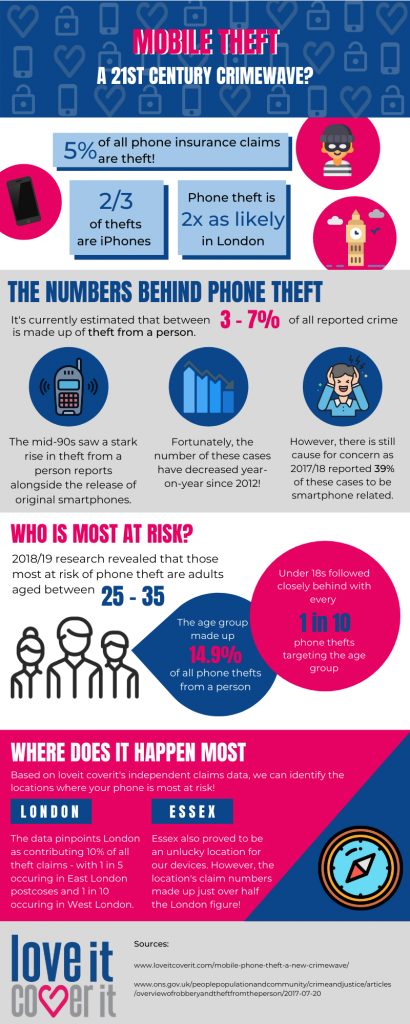Smartphones are oftentimes our most valuable personal possessions, and we always have them on us! This makes them a prime target for thieves and muggers. Unlike credit and debit cards, which can be deactivated easily and have no intrinsic value aside from what they represent, a smartphone can easily be sold off, whether the thieves can get full access to it or not! And this issue is only exacerbated by the fact that smartphones are only increasing in price, as the technology inside them becomes more and more advanced.
In fact, according to the Office for National Statistics, theft from a person accounts for between 3% and 7% of all crimes reported to the police in England and Wales. The majority of these thefts are classed as ‘stealth thefts’ meaning that the property is stolen without the owner being aware; for example, if someone took your phone from a jacket pocket on the tube. This is in contrast to ‘snatch theft’, which would involve the perpetrator quickly taking the property, without force, and fleeing the scene.
The data from the ONS shows that theft from a person (which includes phones) was on a steady incline from the mid-90s onward. One of the main reasons for this is that, around this period, mobile phones were becoming a popular consumer item – and at the time they were very valuable and lacking in modern security features. This trend continued through the 2000s – fluctuating year-on-year, as you’d expect – as mobile phones became more commonplace and the original smartphones were entering the market.
A Problem in Decline
In 2012, the National Crime Survey – which supplies data to the ONS – reported that there were roughly 608,000 theft from a person incidents across England and Wales, which was a high for the decade. However, since then, theft from person cases – including those including smartphones – have fallen year on year. A key factor for this continual decline could be that smartphone security has improved to a point that it’s no longer worth stealing them; with Face ID, trackers, and fingerprint scanners, it’s now harder for criminals to wipe and fence stolen property. It’s also possible that, due to the ubiquity of smartphones, the desire to steal them has simply decreased.
While the decline in personal theft is a good sign overall, it’s important to stipulate that smartphone theft is still a constant criminal threat. For example, between April 2017 and April 2018, 39% of all theft from a person reports in England and Wales were smartphone-related. This was the second-highest stolen personal item, being 10% more likely to be stolen than credit cards, wallets, or handbags. Unsurprisingly, cash was the most stolen item across this time period.
Who is most at risk?
Somewhat surprisingly, in 2018/19 those most at risk of phone theft are adults between the ages of 25-35. According to the research, this age group accounted for 14.9% of all phone thefts from a person. This could be due to the fact that this age group are more likely to have expensive phone models, and are more likely to be in a position where they could have their phone stolen. 1 in 10 mobile phone thefts were committed against children under the age of 18, with 14-17 year olds being the most at risk.
